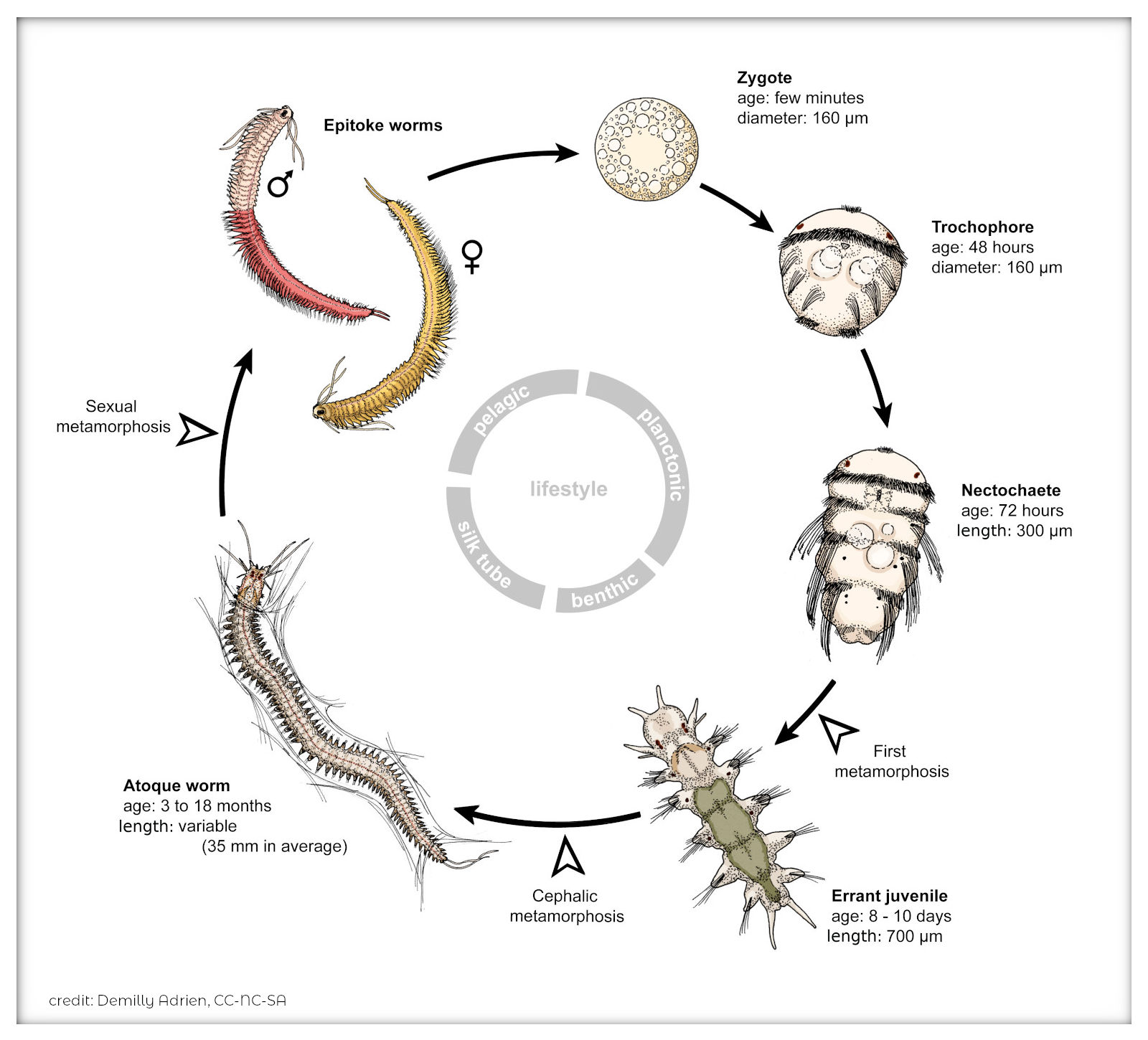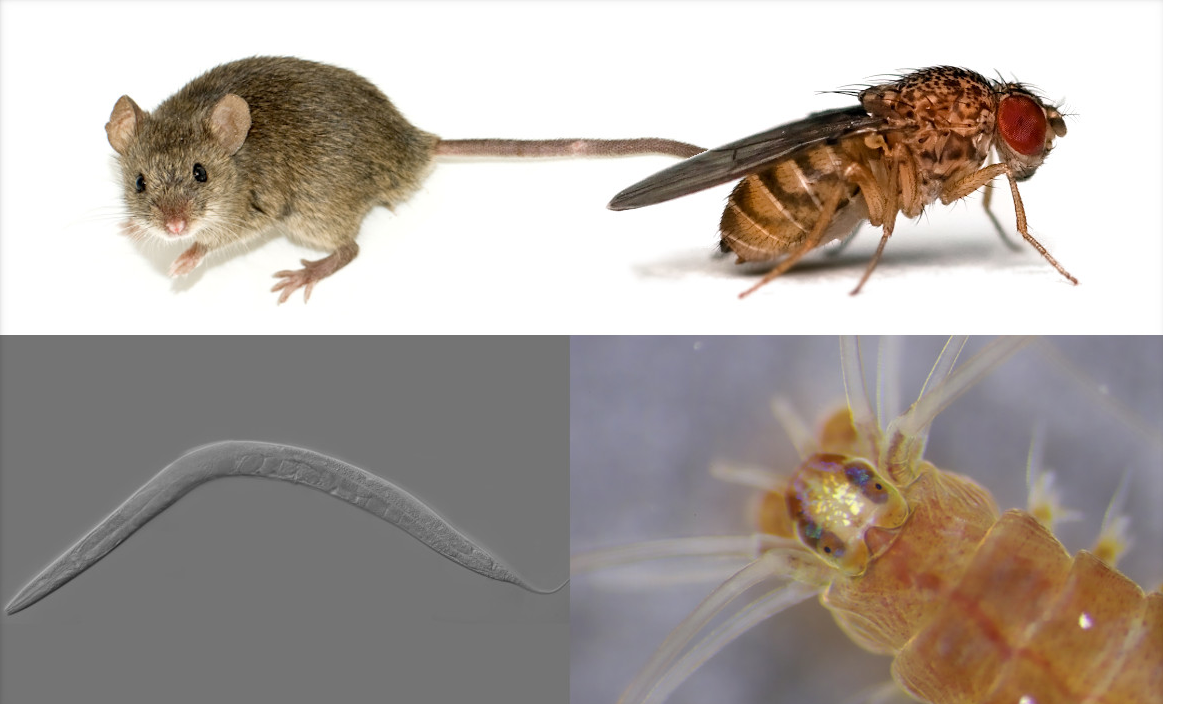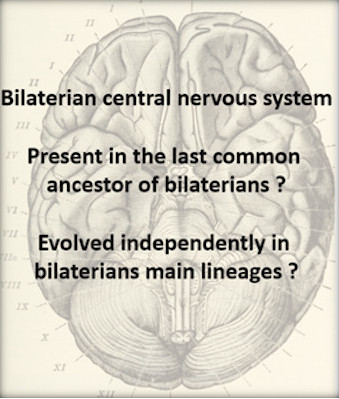Annelids
Chapter 1: Phylogenetic context and annelid diversity
Now that you are familiar with annelid diversity, phylogenetic position and why they are interesting for evolutionary studies, let’s now focus more specifically on Platynereis and its biology.
Chapter 2: Biology of Platynereis
Platynereis’s life cycle

You should now know Platynereis’ body plan, life cycle, reproduction mode, etc. quite well. In the next chapter, you will discover how we maintain and culture the animal, our daily routine at lab.
Chapter 3: Platynereis in the lab
You are now familiar with Platynereis in the lab, but what we can really do technically with this model, to address our scientific questions? Let’s explore this in the next chapter.
Chapter 4: Technical tools to use Platynereis as an evo-devo model
In this chapter of the annelid module, you will have the opportunity to explore various technical tools currently used to address scientific questions using the annelid Platynereis.
In situ hybridization: principle and steps
In situ hybridization (ISH) is the specific annealing of a labeled RNA probe to complementary sequence of a target mRNA in a fixed specimen, followed by detection and visualization of the nucleic acid hybrids. By allowing detection of mRNA in tissues and in whole embryos, this technique enables to get a complete overview on the specific expression patterns of those genes (mRNA) in the course of embryonic and post-embryonic developments (from Baumgart et al., 2001).
Whole-body gene expression pattern registration:
This technique allows the rigorous comparison of expression patterns, at a specific developmental stage, of an animal which harbors invariant development. It requires a standardized reference template at the desired developmental stage and allows the production of a standardized digital anatomical atlases of gene expression patterns, at the near-cellular resolution (from Asadulina et al., 2012).
Platynereis egg injections
Thanks to animations and tutorial videos, you have now an idea of the variety of techniques available for this powerful developmental biology model. In the next chapter, you will explore how such tools have been used to address a key question in the Evo Devo field: the evolution of the bilaterian nervous system.
Chapter 5: Platynereis as a model for studying the evolution of the nervous system
In this chapter of the annelid module, you will have the possibility, through scientific literature, to explore one of the key questions in the Evo-Devo field: understanding the origin and evolution of bilaterians’ nervous system. How did our central nervous system appear? What did it look like in the first bilaterian species? How did it function? By studying and comparing known situations in well-established models such as vertebrates, Drosophila, Caenorhabditis and Platynereis worms (as well as other less conventional model species), researchers have proposed two distinct evolutionary scenarios about the evolution of the central nervous system that you will discover in the proposed papers.

In a seminal paper 10 years ago, Alexandru Denes and colleagues from the Arendt lab investigated the molecular architecture of the trunk nervous system in the annelid Platynereis dumerilii and compared it to vertebrates. Their data indicate that a mediolateral architecture of the nervous system was already present in the last common bilaterian ancestor and thus support a common origin of nervous system centralization in Bilateria. This paper was followed by a series of very interesting papers investigating several aspects of Platynereis’ nervous system development.
Denes, A.S. et al. Molecular Architecture of Annelid Nerve Cord Supports Common Origin of Nervous System Centralization in Bilateria. Cell. 129 DOI 10.1016/j.cell.2007.02.040 (2007).
One of them, from Adrien Demilly in the Vervoort lab at Paris, highlighted the involvement of the Wnt/b-catenin pathway in the control of neural cell proliferation/differentiation in both vertebrates and Platynereis.
Demilly, A. et al. Involvement of the Wnt/b-catenin pathway in neurectoderm architecture in Platynereis dumerilii. Nat. Commun. 4:1915 doi: 10.1038/ncomms2915 (2013).
With the advance of new techniques such as image registration that you have seen in Chapter 4, Vergara and collaborators were able to investigate the expression of more than 100 neural genes in Platynereis and compared them to vertebrates, revealing the Evolutionary Conservation of Motor and Interneurons at the bilaterian scale.
Vergara, H.M. et al. Whole-organism cellular gene-expression atlas reveals conserved cell types in the ventral nerve cord of Platynereis dumerilii. PNAS. 114:23 (2017).
In marked contrast, J. Martin-Duran from the Hejnol lab and collaborators, studied representatives of Xenacoelomorpha, Rotifera, Nemertea, Brachiopoda, and other species of Annelida and proposed a totally different scenario for the evolution of the bilaterians’ nerve chords.
Martin-Duran, J. et al. Convergent evolution of bilateria nerve cords. Nature. 553 doi:10.1038/nature25030 (2018).

As you will see in detail when reading those papers, the long-lasting question of the evolution of the central nervous system is still not fully answered …
This module will continue during the Schmid Training Course, where you will discover the advantages of Platynereis for stem cells and regeneration studies.
Teacher: Eve Gazave
